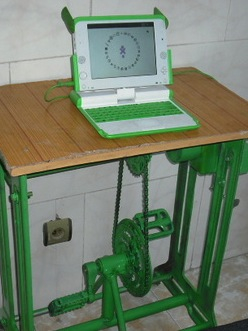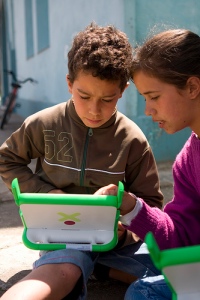I was in the Peace Corps in Cape Verde as an ICT volunteer from 2006 to 2008, and while I was there, the One Laptop Per Child project came on my radar and I became pretty enamored of the prospect of bringing some XOs to the country, or at least raising awareness of the idea within the government.
However, after considering all the obstacles with some fellow volunteers and local educators, including a Ministry of Education delegate, I kept running into the same issue: So we get the laptops, and then what? We discussed the potential of OLPC endlessly, but eventually came to the conclusion that the program was a mess, especially after the departure of some of their best minds and the insistence that the hardware is the only thing to supply. But if OLPC itself won't supply the rest of the framework, somebody must.
Ignoring all other issues - Is OLPC worth it cost-wise? What about the XO's hardware? Does it encourage constructivism in the classroom? What countries are appropriate for this? - I'll focus on what I know.
Connectivity & Power
One of the foundations of the XO is connectivity, and of course the infrastructure is lacking in most target countries. A knowledgeable partner needs to facilitate the development of internet access at usable speeds, whether it be wired or wireless, at a sustainable pace. The advent of numerous new undersea cables all around Africa will doubtlessly contribute here.
Power infrastructure is also needed; this is all useless without it, even with power-sipping ULV chips. Renewable and accessible sources of energy need to be there before school servers can even boot for the first time. These two issues are obviously bigger than OLPC and are major driving forces in development; I cite them because they are so fundamental and necessary for the success of any OLPC-style program.
Despite the huge scale of the problem, any initiative of this type needs to have its fingers in this pie and be connected with infrastructure development partners to get anywhere.
Software
Along with the physical infrastructure, you need a software ecosystem. Leaving Sugar out of the equation (I'm a fan, but not everyone is; plus, more choice is always better), you need content developers constantly innovating to produce high quality educational programs and knowledge portals.
This could be the MoE developing software on the government's dime, or better yet for private sector enthusiasts, budding software companies can produce the programs, encouraging small business growth in the ICT sector and getting new programmers on their feet. Furthermore, technical and vocational students in more developed countries can undertake the programming themselves, hitting even closer to the heart of OLPC's aims.
No matter what, this won't happen without a coordinating entity, a role that OLPC has been unwilling and/or unable to step into.
Teacher Training & Content
Finally and most crucially, teacher training and educational materials need to be brought into the equation. No matter how simple the XO is, using it in a classroom requires a major rethinking of how education is undertaken in most schools around the world, and 99% of teachers out there just won't be able to do it without assistance.
Like infrastructure, this is so big and so obvious that it seems outside the scope of OLPC. Train teachers? No kidding! Don't you think thousands of people are already trying to do that?! Naturally. But any ICT4E program needs this at the center of its aims, and OLPC's failure to incorporate this into its program has been a massive hindrance to adoption.
If Not OLPC, Who?
OLPC isn't going to do any of this. So who will? Why not a non-profit composed of equal parts techies and educators? Small teams of dedicated professionals could ease to roll-out of educational computers to the appropriate countries over the course of a few years, on a cost-shared basis between donors and recipient governments.
They don't even need the XO - many have pointed out that more capable netbooks have undercut OLPC in cost at this point. OLPC started it, but this is the next logical step.
Leland Smith wrote this post as part of the month-long discussion around One Laptop Per Child Impact on Educational Technology Debate




where can we find the plans for the pedal powered bench?
As an educator, I purchased 2 OLPC one for self and one for a child in need. I have taken the time to learn much of the apps that were available and show my students how some of them work using the desktops we have.
I am glad the initiative that OLPC took. It opened up a whole new world of computing to me. I am currently trying to encourage my students to look at the open source apps that are available. They are the future coders and contributors to spread of technology for all children. They are also the next innovators. I would enjoy working with teachers around the world to share what I have learned. I am currently using the ScratchEd site to learn and educate my students this application for programming.
I hope the OLPC develops additional equipment. I will buy it!
What you have described here is very similar to what is happening in Nepal, a programme implemented by OLE Nepal. Check out the first newsletter for detailed information: http://www.olenepal.org/ole_newsletter/OLENepalJanFeb10.pdf